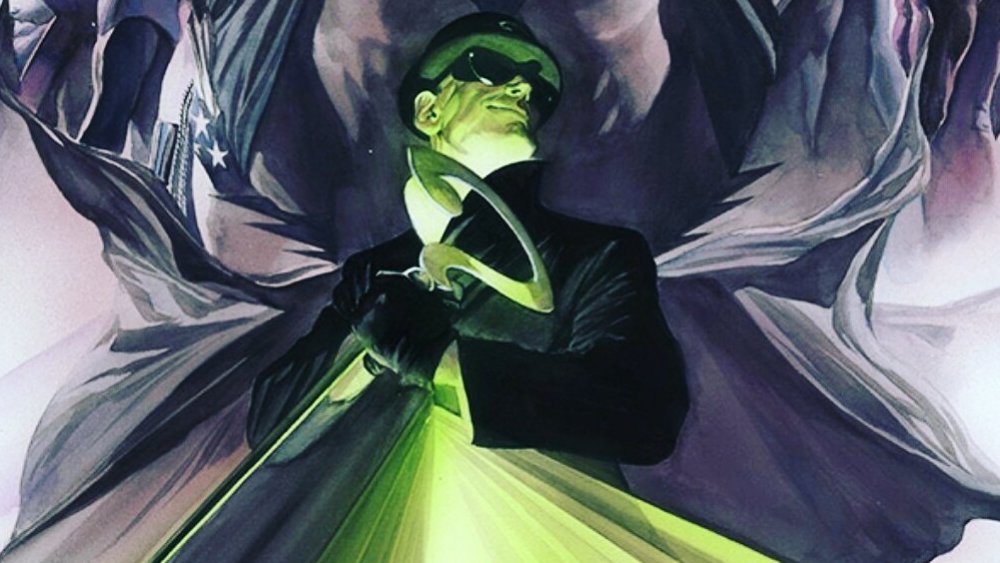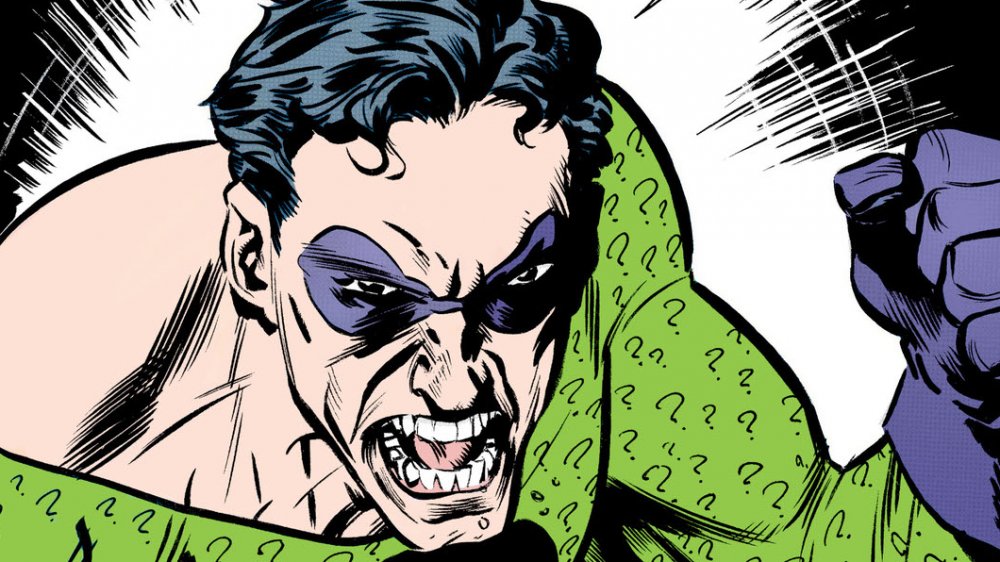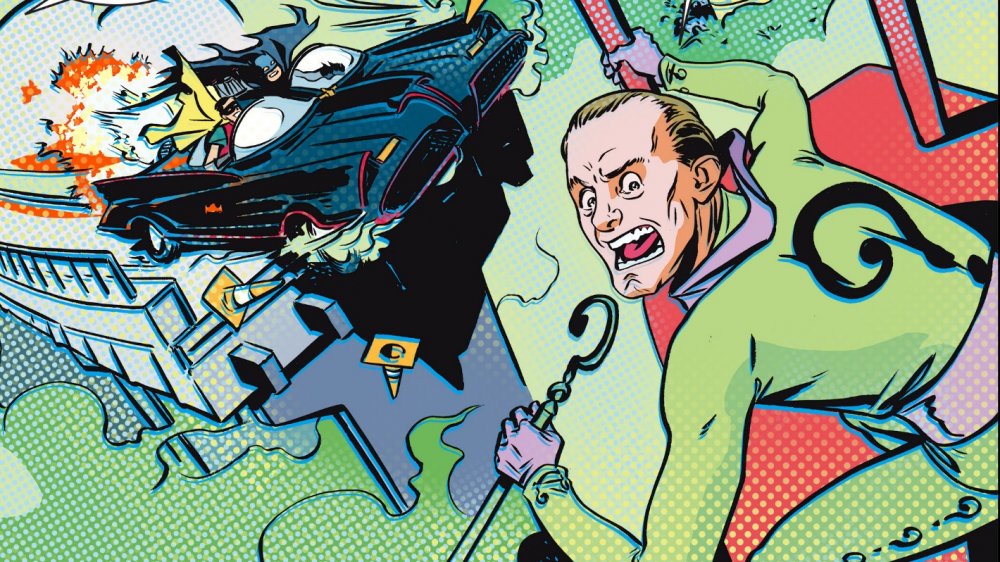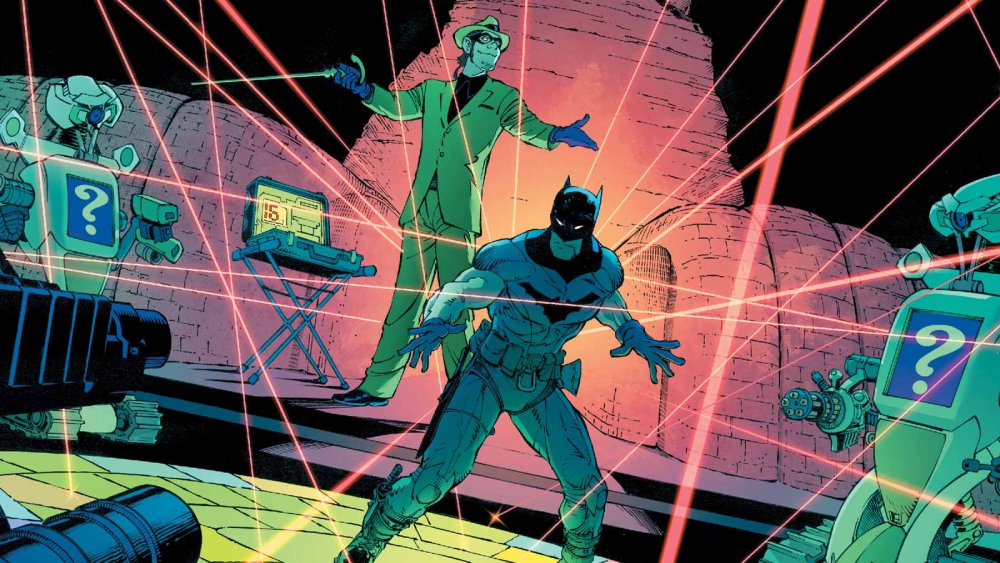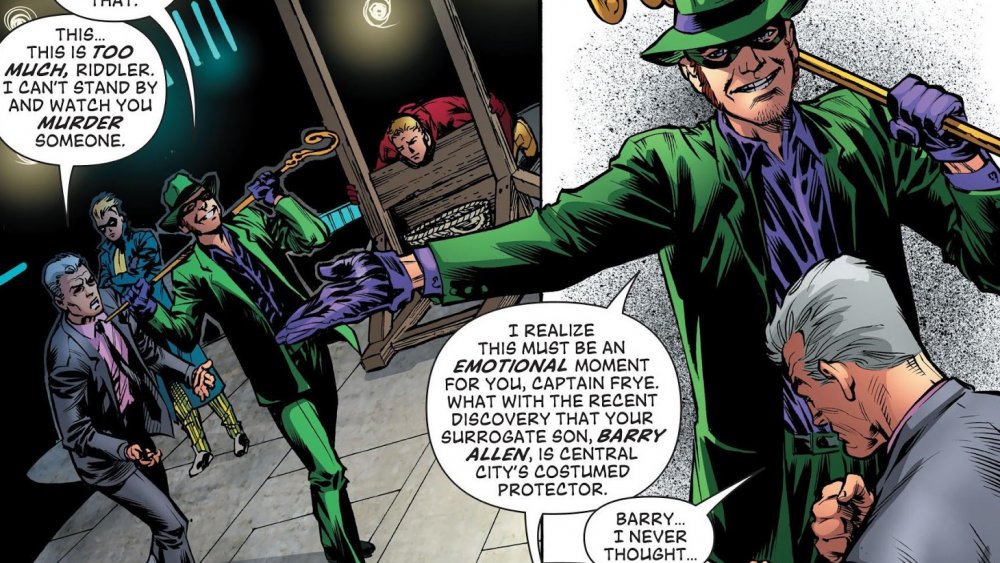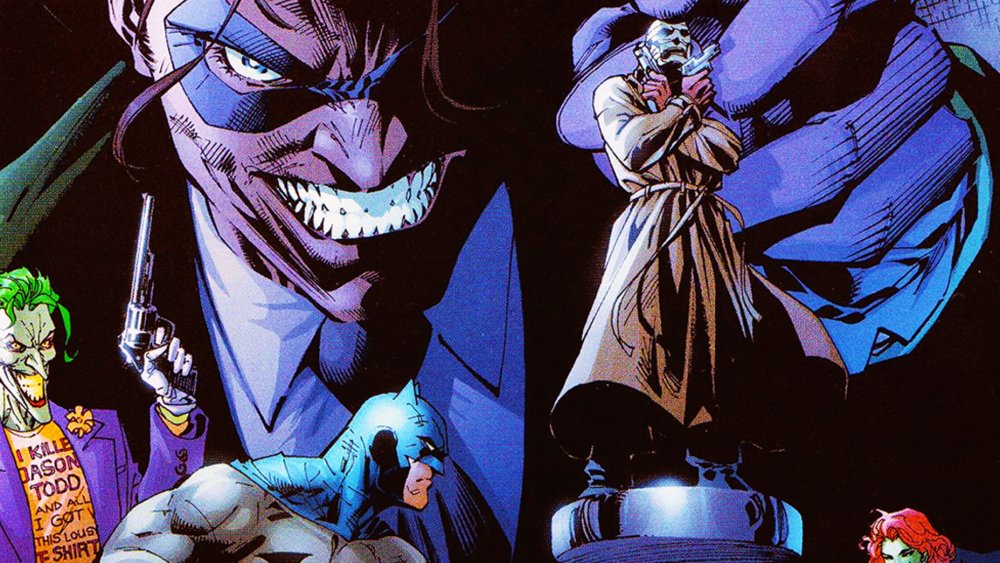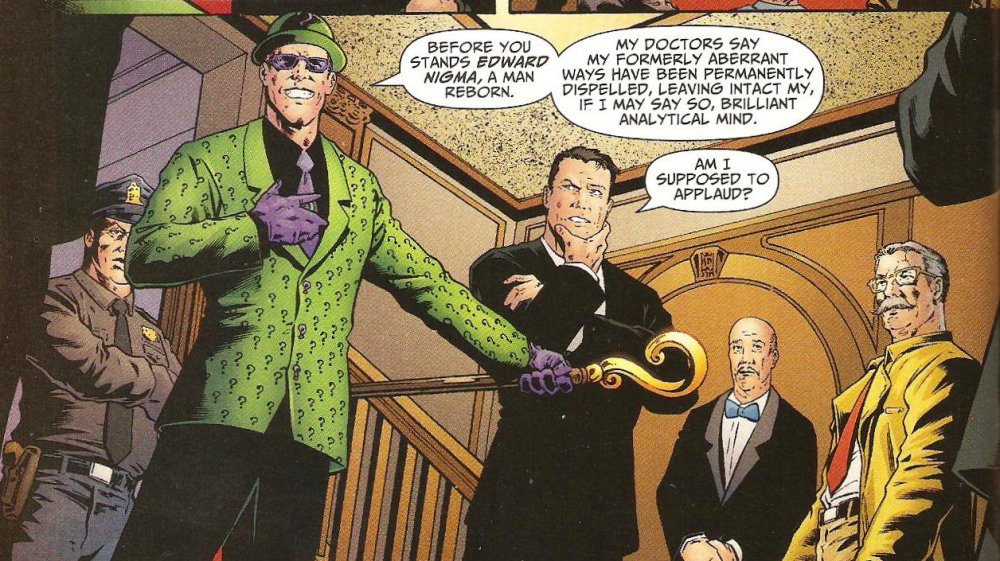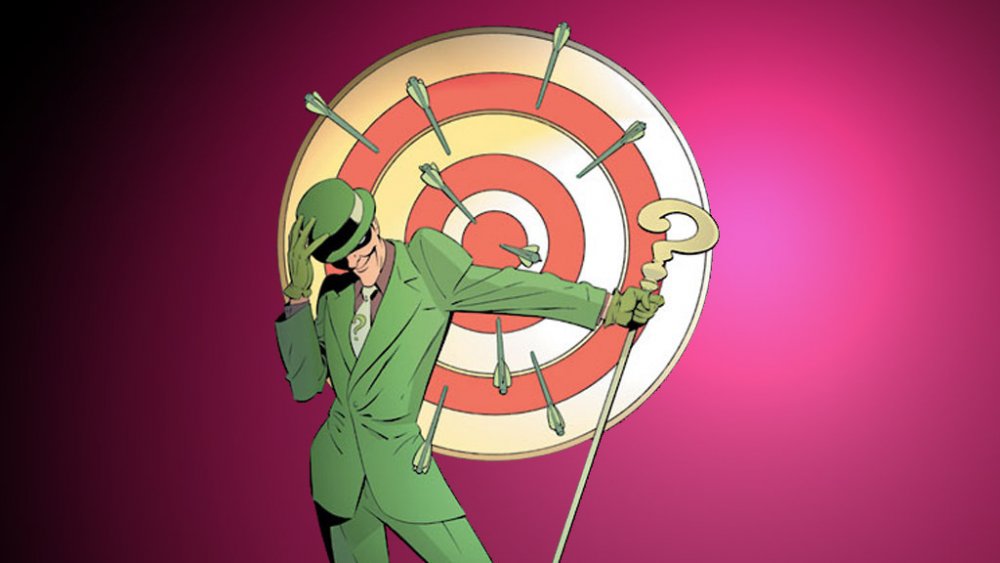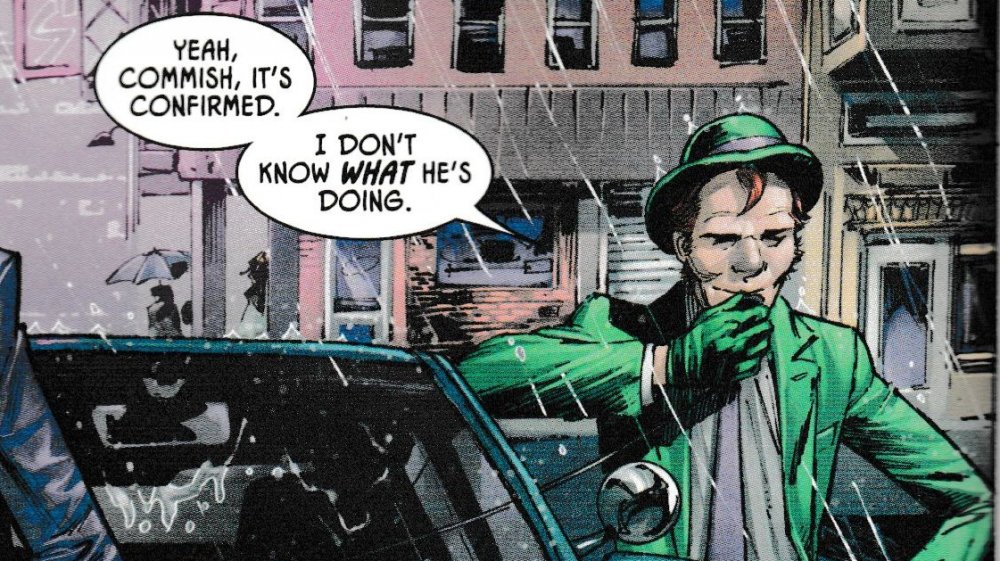The Riddler's Entire Backstory Explained
There's quite a bit of joy in being a second-tier comic book villain. Sure, you might not get the gritty graphic novels and Scorsese-lite origin stories of the Joker, but you also get the sublime feeling of really committing to an absolutely ridiculous bit. The Riddler is a prime example of the fun to be had by a Batman B-lister.
While the majority of Batman villains are fairly heavy hitters, Edward Nygma just gets to kick around Gotham City leaving cartoonish question marks in his wake. His crimes aren't rooted in the same causes as real-world grifting and theft. He's not driven by sheer desperation or unchecked greed to cross well-established moral lines. He's just a crazy guy who enjoys feeling smart and really likes puzzles. And that's just fine by us.
All that being said, the rules of comic book writing and the guidelines of gimmicks dictate that the Riddler had to come from somewhere. And in the decades since his first appearance, DC has done an excellent job laying out the who, what and why of the Prince of Puzzlers. Here's the Riddler's entire backstory explained.
Edward Nygma's youthful obsession
Young Edward Nygma wanted to be lauded for his intellect. In order to learn as much as he could, he spent his childhood at the feet of the adults around him, peppering them with constant questions. In the DC annual story "Questions Multiply the Mystery," Nygma is shown to be a nuisance. His desire for attention and knowledge earns him no points with those who know him.
Eventually, a teacher in his grade school announces a puzzle-solving contest. Whichever student could solved a puzzle in the shortest time would win an unspecified prize. Desperate for validation, Nygma breaks into the school after hours and practices the puzzle until he can solve it in 15 seconds. He easily beats his classmates, earning the praise of his teacher as she gifts him a book of puzzles, forging a lifelong connection in the unstable young man's brain between puzzles and praise. He celebrates his win for an entire week, attracting the attention of school bullies and diving deeper and deeper into the world of puzzles to escape his tormented school life, memorizing the ins and outs of different head-scratchers.
An honest living
Nygma's obsession with riddles carries on into adulthood, and he makes it work for a while. While the lingering longing for recognition remains, he's able to suppress it for a bit in service of an honest-ish living: He falls in with a carnival, making his money with scams disguised as games and outsmarting marks on the midway.
He devises a game that turns into a modest income by challenging carnival strollers to solve a puzzle and win a prize. It costs nothing to play, but contestants have to pay up if they lose. Like the puzzle contest of his youth, Nygma feels the need to cheat to ensure the outcome, and rigs the puzzles to be unsolvable. He takes in enough to get by this way, but it isn't enough to keep him entertained for long.
The money and the thrill of getting away with petty scams leaves Nygma hungering for more. He wants to feel like the smartest man in the room and pulling the wool over the eyes of crowds dazed on cotton candy, flat beer, and carnival rides simply doesn't cut it — the stakes have to be higher, the contestants smarter. Nygma sets his sights on besting folks whose entire career is noticing patterns and untangling puzzles: Gotham City Police Department detectives.
Diminishing returns
Nygma created the alter ego of the Riddler and started teasing police with riddles and coded messages that explained his planned crimes. He got a thrill out of pointing the authorities in the right direction, dropping clues and still successfully pulling off his heists with minimal interference. Riddler dreamed up ever-more-daring capers wearing a domino mask and a question-mark covered unitard to conceal his identity. Gotham police began to figure out his clues and came closer and closer to nabbing him with each successive burglary.
Eventually, his wave of brazen thefts caught Batman's attention. The Caped Crusader correctly guessed that Nygma's next crime would involve a labyrinth based on the clue "Why is corn so hard to escape from?" (Answer: because it's "maize.") Nygma lured Batman to the scene and then ran into a maze of his own design, filled with puzzle-based traps and deadly contraptions. When Batman found himself deep in the maze, the Riddler revealed that he'd hidden a bomb along the way out. Gotham's favorite vigilante just barely managed to escape the blast, with the villain seemingly falling off a nearby pier to his death. Sharper readers (or anyone who'd seen Batman Forever) knew that the Riddler made it out just fine.
Bouncing around the DC universe
The Riddler has never been content to match wits with just one crime fighter. He's bounced around the DC universe, taking on everyone from Green Arrow to Wonder Woman. In one particularly fitting contest, he took on the Question. The Riddler is traditionally nonviolent and more than a little goofy, and his gimmick has left him a reputation as a sort of two-bit bad guy. When a woman on a bus with the Riddler reveals that he's small potatoes to the average Gothamite, he snaps.
Tired of feeling like a second-rate villain, the Riddler hijacks the bus and goes on a bloody crime spree, stopping the bus to ask riddles and kill anyone who can't answer correctly. He makes it to Hub City, where the Question finally stops his murderous run with a series of questions of his own. A series of unanswerable philosophical queries sends Nygma into a spiral, incapacitating him until he solves a final riddle and escapes authorities.
The Riddler's partners in crime
The Riddler isn't a marquee villain, so he frequently works with other criminals and rogues. He's enlisted the services of just about everyone in Gotham's seedy underbelly, from Harley Quinn to Catwoman. He occasionally worked with the late Cluemaster, even though their gimmicks were close enough to give Nygma agita.
Most famously, he teamed up with the villain Hush for the beloved comics arc of the same name. After a city-wide crime spree involving just about all of Batman's biggest villains, the Dark Knight realizes that the mysterious mastermind behind it all is his childhood friend Dr. Thomas Elliott. The doctor blames the Wayne family for keeping his own parents alive and holding up his inheritance of their wealth, and he orchestrates a plot to get revenge on the last living Wayne. After everything is revealed, it's almost entirely the work of the Riddler behind the scenes.
After learning he has a brain tumor, Nygma uses Ra's Al Ghul's healing Lazarus Pits to cure his condition. He raises the possibility of using the pits to help his doctor, Thomas Elliott, whose mother is also suffering from cancer. He offers the use of the pit at a steep fee, only to find that Elliott wants his mother dead and blames the Waynes for her long life. Intrigued, he nudges the enraged doctor into pulling off the massive plot that very nearly kills the Caped Crusader.
The Riddler going straight
The Riddler's life frequently turns on traumatic brain injury, and a good example of this principle in action is the arc that begins when another knock to the head pushes Edward Nygma back onto the straight and narrow. He loses his desire to commit crimes after Shining Knight puts him in a coma. Even as an ordinary citizen, he still has a love of solving puzzles as well as a need to be praised for his massive intellect. He starts working as a private eye, solving crimes alongside his longtime nemesis Batman.
He's good at it, too — he frequently comes to conclusions and susses out crimes a step or two before Batman. At one point, he figures out the identity of a serial killer's upcoming victim even though Batman needs the help of his supercomputer just to get there slower. As Batman's sidekick Dick Grayson grinds toward unearthing the real killer, the Riddler's cunning frequently allows him to save the lives of would-be victims.
The reason that the Riddler was so good at predicting the moves of the killer becomes clear as the story goes on: The culprit, the murderous Conundrum, grew up idolizing the Riddler, and has been working to fill the void left by his retirement from villainy.
The Riddler gets back at it
Nygma is able to stay on the right side of the law until yet another brain injury awakens his desire to commit crime. The Riddler returns after trying to thwart Catwoman as she robs one of Gotham's endless fancy galas. A bomb detonates as he's chasing Catwoman away from the party, rattling his brain and unearthing his dormant alter ego.
The new Riddler manages to keep up his façade as a private eye for a while, but it's clear that the newly reborn villain is far more vicious than his previous incarnations. He runs a scheme with Two-Face against the mobster Mario Falcone. Falcone has taken Two-Face's all-important coin and he calls in the Riddler and his daughter Enigma to get it back.
Yet again, the Riddler is driven into a murderous rage when someone implies he's a less-than-stellar criminal. At the end of the arc, Enigma calls her father a "has-been." While he appears unfazed by the remark, the comic makes it clear that he murders her after asking "What's green and purple and bleeds profusely?"
A comfortable life
In recent years, DC Comics have seen the Riddler leveling out in his own peculiar way. In The New 52 and Rebirth, Nygma seems content to just hang around Arkham Asylum with very little happening in the way of his former mega-schemes. At one point, after being hit with Joker Gas, he calmly demonstrates that he could have walked out of the asylum at any time.
That's not to say that the Riddler doesn't get anything to do in these new titles. In a flashback to the events of Year One, he gets in a long-term gang war with the Joker, the Big Bad himself. But present-day Nygma is more than happy biding his time in the asylum and pulling tricks on guards.
